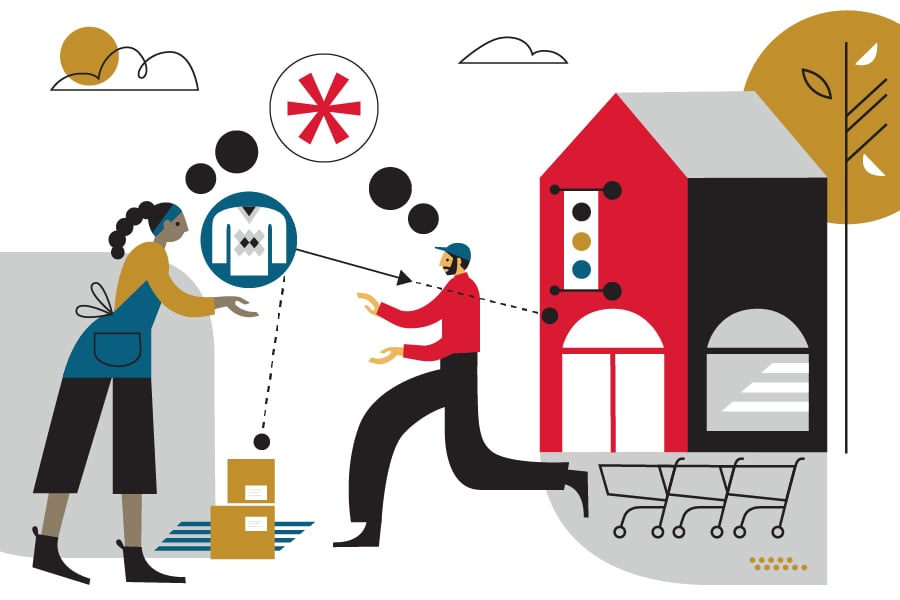Logistics
Warehousing & Fulfillment
Transportation
E-commerce
E-commerce Fulfillment Services
Lease & Maintenance
Semi Trucks
Supply Chain Technology
Logistics
E-commerce
Lease & Maintenance
Buy Used Trucks

By now, brands are accustomed to skipping traditional retail partnerships in favor of selling directly to customers. The massive growth of direct-to-consumer retail over the past decade has permanently rewired how brands and consumers alike think about e-commerce fulfillment, brand identity, and customer loyalty. Never before have consumers had more ways of connecting with brands, ushering in new expectations surrounding the customer experience.
The next phase of retail transformation? The growing popularity of direct-to-retail (D2R).
The purpose of direct-to-retail is to establish closer, more transparent relationships between manufacturers and brands, eliminating inefficiencies that accompany traditional wholesale distribution.
In this blog, we delve into the key distinctions between D2R and traditional wholesale, exploring the benefits this approach brings to retailers, from improved profit margins to streamlined inventory management. Additionally, we examine the accelerated journey of products to the shelves, increased customization opportunities, and the evolving landscape of direct-to-retail as a pivotal force in the retail industry's future.
Direct-to-Retail, often shortened to D2R, is a retail and supply chain strategy where manufacturers sell their products directly to brands and retailers, rather than traditional intermediaries like wholesalers or distributors.
The purpose of direct-to-retail is to enable brands and manufacturers to form a closer relationship that eliminates many of the inefficiencies that exist in traditional wholesale activities. It gives manufacturers more transparency over how and where products are being sold to the end consumer, so they can refine their product mix to reflect consumer preferences. For brand owners, D2R allows them to access products faster and at a reasonable price, meaning increased profits and happier end consumers.
In traditional wholesale distribution, the manufacturer will sell products to a wholesaler, in who turn sells the merchandise to retail stores. Distributors act as the middlemen between manufacturers and retailers, making a profit by sourcing desirable products and reselling them. This requires distributors to undertake granular forecasting of consumer demand and market trends to establish long-term relationships with brands, ensuring they are sourcing merchandise that is highly sought after by consumers.
In a direct-to-retail model, there are no intermediaries between the manufacturer and the retailer. Instead, products move directly from the manufacturer to the brand that is making the purchase. This direct partnership opens up more opportunities to negotiate in areas such as pricing, product customization, shipping strategies, and more.
Better profit margins
By removing the middlemen, direct-to-retail often results in better cost savings not only for retailers but for manufacturers, too. The parties get to negotiate pricing directly and with more transparency, helping to make up for the margins traditionally lost to distribution.
Streamlined inventory management
Striking the balance between too much and not enough inventory is complex for the retail industry at the best of times, but is especially difficult when working with wholesalers. The timeframe for processing requests for replenishment inventory can vary hugely, depending on the time of year and the demand for different products. Delays in new inventory arriving can result in stockouts within physical stores or delays in fulfilling direct-to-consumer orders, which is bad for a brand's reputation. Alternatively, retailers may receive inventory at the wrong time, causing surplus inventory to pile up and increase storage costs.
In a direct-to-retail model, brands can work directly with manufacturers to manage their stock levels and keep them updated on the latest sales activity. This makes it possible to reduce excess inventory and respond more efficiently to sudden changes in consumer demand.
A faster journey to the shelves
By streamlining the supply chain, brands experience a much faster route to market for their products. rather than moving between successive warehouses, fleets, and receiving workflows, merchandise is sent directly from the manufacturer to the brand's facility or their 3PL.
Moreover, this direct transfer of goods opens up more opportunities for brands to work with manufacturers to create a more efficient packing, routing, and receiving process designed specifically for their facility. Things like tailored labeling or ship notices lessen the time it takes for fresh inventory to be unpacked, inspected, and sent to the right section of the fulfillment center for picking. This helps reduce unnecessary stockouts and ensure that sales opportunities are maximized.
More brand/customization opportunities
When brands are purchasing products from wholesalers, they have limited influence over product specifications and characteristics. What merchandise they have access to may also be limited by metrics such as minimum order quantity or sales figures, especially in the case of sought-after merchandise that many retailers are competing to stock in-store.
When manufacturers sell products directly to brands, there is more opportunity for collaboration and customization throughout the manufacturing process.
For example, if a brand knows that certain colors or sizes are proving to be very popular with consumers for the upcoming season, they can work with the manufacturer to produce more SKU variations.
Alternatively, product customization could be as simple as getting your brand's logo printed onto the product, or premium branded packaging to celebrate a limited-edition release. As well as providing a more consistent brand experience, this enables businesses to put a unique twist on more generic products, giving them a strong competitive differentiator.
Even as wholesale begins to rise in popularity after the dominance of direct-to-consumer selling, brands have adapted to the convenience and cost savings that come with cutting out the middlemen. The D2C retail revolution saw brands benefit from greater connectivity with consumers via digital channels, allowing them to gather valuable data to inform product selection and selling strategies. In the same fashion, direct-to-retail is enabling retailers and manufacturers to develop more collaborative relationships that lead to better profit margins and demand forecasting.